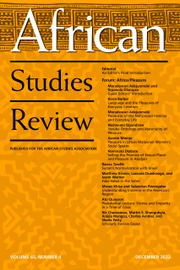In Mozambique, the spiritual and material worlds are closely intertwined. Christy Schuetze illustrates this in her recent work, which stems from nearly two decades of fieldwork in the Gorongosa district of Central Mozambique. The author expanded her ethnographic research by surveying 334 households to assess their socioeconomic conditions.
The book examines the recent emergence of an “epidemic” of possession among women of childbearing age by male spirits, exploring how significant economic changes have disrupted relationships and marriages, intensifying the sense that the world is out of balance. In line with a common logic present throughout the political and religious history of this region of Mozambique, a woman possessed by a non-kin spirit, often of foreign origin, may accept the role of “spirit wife” and commit herself to her spiritual husband. In return, the same spirit can bestow new healing powers on his living wife, transforming her into a spiritual healer. This proliferation of possession is directly linked to the emergence of new female healing networks, both at the traditional level (considering “tradition” as an active, continually transforming process) and within the Pentecostal churches. Contrary to authors who consider Pentecostalism a complete break with the past, Schuetze views these two realities as part of a dynamic continuity that shares a framework centered on healing: in both realities, women seek gara detu—a local notion related to collective well-being.
Schuetze contributes to the existing body of literature on the “spiritual husband” phenomenon in Mozambique through a comprehensive ethnography that incorporates social, economic, and historical perspectives, providing detailed descriptions of the various categories of spirits present in the region. Like other scholars, the author links the spiritual husband’s possession to population experiences, including pre-colonial wars, colonial forced labor, the civil war, and recent socioeconomic changes. As historical conditions change, so do the identities and stories of the spirits that possess the living. The book explores these changes in depth in Part I: Gorongosa’s inhabitants face significant socioeconomic challenges and breakdowns in relationships that once offered control and well-being, leaving a pervasive feeling that the world has turned upside down. The socioeconomic changes in Gorongosa, from colonial times to the Structural Adjustment Program reforms, are examined while also paralleling related spiritual transformations. Austerity reforms significantly disrupted Mozambique’s infrastructure and services, particularly in the health sector, leading to land alienation, economic exclusion, and the forced migration of young men to urban areas. Economic changes compelled individuals, primarily men, to seek wealth outside family ties and social networks, concentrating on financial gain instead. Many residents of Gorongosa report that this pressure has driven some men to turn to witchcraft, seen as an act of social predation, to obtain the spirits of unidentified deceased individuals. These spirits are believed to provide the ability to quickly acquire wealth, although they require substantial compensation in return. In most instances, this compensation entails the spirit marrying a woman from the debtor’s family.
At this point, where monetary, material, and spiritual debts intersect, women emerge as both victims and healing agents. By embracing the role of spirit wives and caring for the spirits and their demands, women transform their spiritual husbands into allies and new sources of domestic authority, even within their marital relationships. In the Pentecostal context, churchwomen conceive of their relationship with Jesus as a marriage, positioning themselves in a state of servitude while channeling his transcendent power.
According to the author, while being a spirit wife provides some empowerment and financial independence, it does not challenge the social system. Building on the work of Mary Keller and Saba Mahmood on possession, as well as the contributions of African feminist scholars, Schuetze cautions against overlooking local codes and value systems that may not align with a Eurocentric feminist perspective. She advocates for a reevaluation of the concept of an autonomous subject that emerged with Enlightenment thinking. In Gorongosa, collective healing often takes precedence over individual female emancipation, and women are not singular agents in the healing processes. Spirit possession is not suggested as a form of masked resistance or protest in patriarchal contexts, as argued by Lewis, Boddy, or Bourguignon; Schuetze proposes a more nuanced understanding of it: possessed women who agree to submit to mediumship initiation do so frequently as an act of resignation and desperation (p. 183), often pushed by their elders. They interpret this act as therapeutic, offering relief to a broader group.
It is important to highlight that Schuetze, having engaged the reader in the spiritual realm of Gorongosa and its socioeconomic background, steps away from a romanticized and exotic view of the spiritual husband phenomenon. While the functionalist interpretation of this phenomenon may seem reductive, I believe it is crucial to keep in mind that spirits act as a means of expressing social injustice in a deeply marginalized and impoverished environment, like rural Mozambique—an aspect that should remain central to our analysis, as demonstrated in Schuetze’s work.

